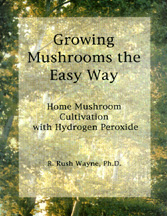

Volume I of Growing Mushrooms the Easy Way is both an indispensable introduction to the use of hydrogen peroxide in mushroom culture and a general primer on basic mushroom growing. It describes techniques for preparing mushroom cultures without air filtration or sterile facilities, and without autoclaves or pressure cooking of bulk substrate. And it contains crucial information--not repeated in Volume II--on:
Continue on down the page or click to read an excerpt from the Introduction to Volume I, or to take a look at the Table of Contents for Volume I.
Both volumes are written for beginners as well as experienced growers, with all the main procedures cast into the form of numbered steps. Volume I is 36 pages long, not including the Table of Contents.
After considering these requirements briefly, I put aside the thought of growing mushrooms. I wasn't about to get all that equipment, and I figured I probably wasn't cut out for the job anyway. From what I could gather, my house would be a death trap for mushroom cultures. Neither my wife nor I are careful housekeepers. We have unabashed dust and clutter, and green and white fuzzy things can be found in and outside the refrigerator. Although I was skilled at sterile technique from my years as a graduate student in biochemistry, I didn't think that would save me from the legions of eager contaminants that would surely dog my every movement should I attempt to grow anything so delectable as mushrooms.
Table of Contents
Preliminaries
Harvesting
I first published Volume I of the peroxide manual as Growing Mushrooms with Hydrogen Peroxide in December 1996. Two years later, I released a second edition, revised and enlarged. The Third and latest edition, entitled Growing Mushrooms the Easy Way, came out in January of 1998, and it was revised in November, 1999. The latter edition has now become Volume I of the peroxide manual with the release of Volume II in August, 2000. Volume I was again slightly revised in September of 2001.
Excerpt from the Introduction to
When I first took an interest in growing mushrooms, I checked out a well-known book on mushroom cultivation from the library and eagerly read through it. But my interest soon turned to general discouragement as I read about all the equipment and procedures the book insisted were necessary to grow mushrooms without getting the cultures contaminated. I would need a sterile laboratory space with a laminar-flow hood fitted with electrostatic and HEPA filters and an ultraviolet light. This space would need a sterile air-lock entry way with a foot wash, and I would need to have special clothing to enter it, so that I could wash down the floors with chlorine bleach every day. My fruiting mushrooms would have to be grown in a separate building altogether, so as to avoid getting spores into the sterile laboratory. These fruiting cultures would have to be grown in specially designed plastic bags with microporous filter patches attached, so that the mushroom mycelium could get oxygen without letting mold spores or bacteria get in. Of course, I would need an autoclave or at least a specially designed pressure cooker to sterilize the media that went into these bags.
Growing Mushrooms the Easy Way, Volume I
Growing Mushrooms the Easy Way
Home Mushroom Cultivation with Hydrogen Peroxide, Volume I
by R. R Wayne, Ph.D.
Introduction
The Mushrooms
Equipment You Will Need
Specialized Supplies You May NeedThe Basics on Peroxide
What peroxide does
Biological effect of peroxide
Advantages of using peroxide in mushroom culture
Contaminant resistance to peroxideWhat peroxide does not do
The need for caution when exposing mycelium
Peroxide is not a sterilant at mushroom-growing concentrationsSafety and environmental considerations for hydrogen peroxide
Peroxide and the spirit of organic growing
Lack of effect of peroxide on substrate or mushroom culturesStability
In pure solution
At higher temperatures
In the presence of peroxide-decomposing enzymes
Guarding the purity of peroxide stock solutionVariations in peroxide concentration from commercial sources
Measuring peroxide concentration
Calculating how much peroxide solution to useGrowing and Maintaining Agar Cultures
Preparing agar plates
MYA medium
Use the lowest effective concentration of peroxide in agar
No-pressure agar medium
Hazards of agar drips and importance of clean plates
Reusing peroxide agar mediumAcquiring mushroom cultures
Importance of starting with good strains
Cloning MushroomsStrain storage
Distilled water method
Keep storage cultures peroxide-freeInoculating and handling agar cultures
Cooling hot scalpels
Inoculating from storage cultures or peroxide-free medium
Preventing occult contamination with bottom inoculation: cleaning the mycelium
Incubating inoculated plates and storing uninoculated platesMaking Mushroom Spawn
Economic advantage of making your own spawn
Advantages of sawdust-based spawn"Ten minute" no-autoclave sawdust spawn
Nitrogen supplements compatible with Ten Minute Spawn
Importance of clean containers in making Ten Minute SpawnPressure-sterilized sawdust spawn
Grain spawn
Difficulties of grain spawn and pitfalls in spawn making
Spawn containers
Inoculating spawn
Agar chunk method
Use peroxide-adapted mycelium for spawn inoculation
Incubating and shaking the spawn
Liquid cultureColonization of bulk substrate
Importance of choosing substrates lacking peroxide-decomposing enzymes
Pasteurizable substrates compatible with peroxide
Recipes for fruiting substratesWood chips and substrate density
Preparing supplemented sawdust with peroxide
Nitrogen supplements for bulk substrate
Calculating how much supplement to add
Measuring pH of substrate
Culture containers
Trash bags as culture containers
Excluding fungus gnats
Plastic buckets as an alternative to bagsInoculating supplemented sawdust
Breaking up spawn for inoculation into fruiting substrates
Adding the spawn to the substrateMushroom formation
General procedures for fruiting oyster-like mushrooms and Hericium
Protecting yourself from spores
Mushrooms needing a casing layerSeasonal planning
Outdoor vs. indoor growing
Trouble shooting
Conclusion